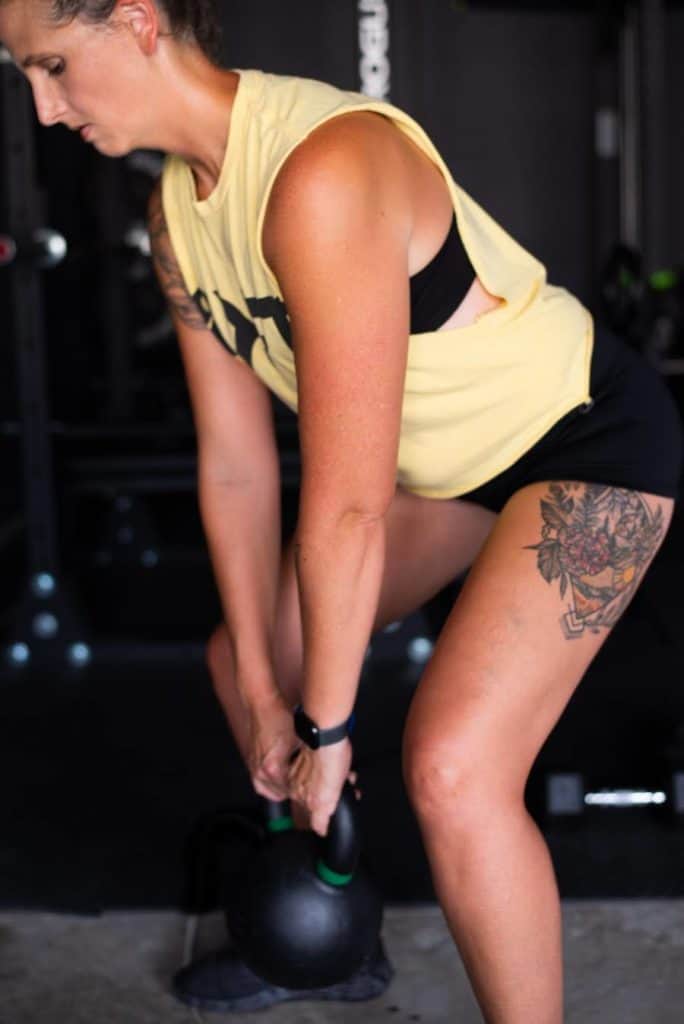Kettlebell exercises are a great functional workout if you want to burn calories, lose weight, and build strength. Here are some of my favorite back exercises using my kettlebells.
A key advantage of kettlebell workouts is that, unlike conventional weight training, they do not focus on specific muscle groups. Rather, kettlebell swings are programmed to flow with the body’s natural movement patterns, so that you move in a way your body was designed to move.
In particular, kettlebell back exercises can help you build a strong spine, which is an often neglected area. This has many practical benefits for your overall built, stabilization, endurance, and strength.
So, what are the best kettlebell back exercises?
I’m going to show you how to do 10 very effective and highly beneficial kettlebell exercises. These exercises will help to improve your posture, develop muscle and tone, burn fat, lose weight, and prevent problems like lower back pain.
Come, let’s take a deep dive into kettlebell exercises for the back. I’ll also show you how to progress from beginner to advanced so that you can get the most out of your kettlebell workout over time.
Muscles of the Back

First, let’s take a quick look at the main muscles of the back which you will be training with these kettlebell exercises.
Rhomboids
The rhomboid major and rhomboid minor are important muscles for upper limb movement and shoulder joint stability.
Latissimus Dorsi
The latissimus dorsi or lats is a large triangular-shaped muscle that helps to stabilize the back and is involved in movements of the arm.
Trapezius
The function of the trapezius or traps is to stabilize the scapula (shoulder bone). It is also important for movements such as elevation of the scapula and extension of the neck.
Erector Spinae
These posterior chain muscles are present on either side of the spine. Their function is to straighten the back and provide side-to-side movement (lateral and medial rotation). Strong erector spinae muscles can help prevent back pain.
In addition to these primary muscles, there are other muscles in the back that are used for stabilization and assistance in movements.
Kettlebell Back Exercises
In the following paragraphs, I’m going to describe some highly effective kettlebell exercises that will help you meet your fitness goals. For each kettlebell exercise, I’ll tell you the steps on how to do it correctly, its benefits, and some precautions.
Kettlebell Halo
Steps
- Start in a standing position with a good posture. Your shoulders should be relaxed. Your knees should be straight but soft (not locked).
- Grip the kettlebell handle by the horns (the vertical sides) so that the kettlebell is upside-down (the ball should be facing up). Raise the kettlebell above your head.
- Move the kettlebell around your head in a circle in one direction. Once you’re comfortable with the exercise, reduce the size of the circle so that it is just clearing your head.
- After you complete a clockwise rotation, do the same in the other direction.
Benefits
The kettlebell halo is a great warm up exercise for the upper body (shoulders and upper back). It activates the trapezius muscles. It can also help you build core stability and strength.
Precaution
You should avoid over-circling during a kettlebell halo. Also, make sure your posture is good, i.e., you’re not using your torso to increase the range of motion.
Kettlebell Single Arm Deadlift
Steps
- Stand with your feet shoulder width apart. Keep a kettlebell on the floor in front of you.
- The movement of the single arm deadlift involves picking up the kettlebell from the floor with your back remaining nice and straight.
- You should inhale on your way down and exhale when you’re pulling the kettlebell upward.
- A variation of the single arm snatch is to hold the kettlebell with both hands or to pick up two kettlebells, one in each hand.
Benefits
The deadlift movement involves almost all the muscles of the body, including the key muscles of the back. This is one kettlebell exercise that you cannot afford to ignore.
Precaution
Start with a light weight and increase the kettlebell weight gradually. Make sure you hinge at the hips and not the lower back.
Kettlebell Single Leg Deadlift
Steps
- Stand on one leg. Your knee should be slightly bent.
- Grip a kettlebell in the hand opposite to the standing leg.
- Bend at your hips and stretch the raised leg behind you.
- Slowly lower your trunk until it is horizontal to the ground.
- Return to the starting position and repeat on the opposite side.
Benefits
This is one exercise that activates muscles throughout the back. It’s a great way to develop a strong core and powerful rotational movements. This can be hugely beneficial if you play racket sports.
Precaution
Make sure you are holding your back and core muscles tight throughout the exercise.
Two-Handed Kettlebell Swing

Steps
- To perform this kettlebell swing, stand with your feet slightly more than shoulder-width apart and keep your spine in a neutral position.
- Grip the kettlebell with both hands in front of your body.
- Keeping your knees bent and hips pushed back, go into a squat-like position, but don’t go all the way down.
- In one fluid movement, push your hips forward and swing the kettlebell forward and up to shoulder height.
- Slowly lower the kettlebell back between your legs.
Benefits
This is another exercise that works all the muscles of the back and can help you develop explosive power and back stability. Plus, like all movements that involve swinging, it has cardio benefits.
Precaution
It is a variation of the one-handed kettlebell swing that you do with one arm at a time. This is one of the most dynamic kettlebell swings you can do. Beginners should be careful to hinge correctly at the hips rather than the lower back to avoid injury to the back muscles.
Kettlebell Regular Row
Steps
- The starting position is upright with the kettlebell at your feet. Take a big step back with your right leg.
- Lean forward and grab the kettlebell with your right hand with an overhand grip. Rest your left elbow on your knee and keep your back straight and torso parallel to the ground.
- Lift the kettlebell to your chest. Focus on using your back and shoulder girdle instead of your arm.
- Your right elbow should pass close to your ribcage when you lift the weight.
- At the top of the movement, ensure you are squeezing your back muscles, then slowly lower the kettlebell.
- Do all the reps with one arm and then switch sides.
Benefits
This kettlebell back exercise is more like a traditional weightlifting exercise in that it can add some serious muscle to your lats and mid back.
Precaution
Avoid hunching at the shoulders. Ensure that your shoulders are down and away from your ears.
Kettlebell Hollow-Body Pullover
Steps
- Lie flat on your back and raise a kettlebell to the overhead position.
- While pressing your lower back into the ground, lift your legs by a couple of inches. At the same time, lift your shoulder blades and arms as well (push up position).
- Make sure your core is tight. Pull the kettlebell in one movement to a position above your chest.
- Hold and then return to the starting position.
Benefits
A hollow body kettlebell pullover is an excellent workout for the core and abs. It also helps to maintain the spine in a neutral position. Your forearms and upper arms also get some workout with this movement.
Precaution
This exercise is generally safe for all fitness levels. However, you might want to avoid it if you have lower back issues and can’t keep your lower back glued to the floor.
Kettlebell Clean
Steps
- The starting position is standing with your feet shoulder-width apart. Keep a kettlebell near your feet.
- Hinge forward and grip the kettlebell with your left hand.
- Stand up with an explosive movement, pulling the kettlebell to your chest, keeping it close to your body.
- When the kettlebell is higher than your shoulder, catch it at your left shoulder and straighten up. Then, slowly lower the kettlebell.
- Once you have completed reps with the left arm, switch to the right arm.
Benefits
This movement follows the deadlift movement in which the kettlebell goes from the floor to a racked position on the chest in a single movement. The trapezius is heavily involved in this movement, as are other upper back muscles. Plus, there are cardio benefits too.
Precaution
Make sure you have the proper form, i.e., your arm is relaxed and you are using your hips to generate the movement throughout the lift.
Kettlebell High Pulls
Steps
- Stand with your feet slightly wider than shoulder-width apart.
- Grip a kettlebell in one hand and lean forward.
- Lift the kettlebell upward, using your hips to drive the movement.
- Keep pulling the kettlebell in a controlled manner until it reaches chin height. Your arm should be almost parallel to the floor.
- You can extend your free arm for balance.
- Lower the kettlebell and repeat.
Benefits
This dynamic movement is a great workout that will get your heart rate up. It focuses on the mid back, which is often ignored.
Precaution
This is a challenging movement. Beginners should perform the kettlebell high pull with caution, preferably under the supervision of a personal trainer. It requires not only good strength in the wrists but also good timing. You should learn to swing the kettlebell or dumbbells with your hips.
Kettlebell Gorilla Row
Steps
- Keep two kettlebells in front of you. Stand with your feet slightly wider than shoulder-width apart. Your knees should be bent.
- Hinge forward so that your torso is nearly horizontal to the floor.
- Grasp the kettlebells, and keeping your shoulders and hips square, row the weight on one side until your upper arm is nearly horizontal to your torso.
- Return to the starting position.
- Repeat on the opposite side.
Benefits
Kettlebell gorilla rows build back strength in your middle and upper back, your lats, and your shoulders. This exercise also improves shoulder bone mobility and abdominal stability.
Precaution
Lift the weights only as high as you can with a good posture to ensure effectiveness and to protect yourself from injury.
Kettlebell Plank Row
Steps
- Start in plank position with your left hand on a bench in front of you.
- Hold one kettlebell in your right hand with your arm hanging down naturally.
- Tighten your core and butt. Row the weight to your ribcage.
- Hold for a moment, then slowly return to the starting position.
Benefits
This exercise is a variation of a regular kettlebell row. It challenges your core and improves back stability.
Precaution
If you can’t hold a plank position, focus on perfecting this first before you attempt the exercise with a kettlebell.
Back Exercises Progression
Here’s a simple but highly effective kettlebell back workout that will help you progress in your fitness goals by gradually stabilizing and strengthening your back.
Week 1
Begin slowly and gradually build up momentum. Don’t try to add heavy weights immediately.
5 repetitions of kettlebell halos in each direction.
8-12 repetitions of kettlebell single arm deadlifts on each side.
Do a total of three circuits with a 60-second rest period between circuits.
Week 2
Now add the following kettlebell exercises to your regimen.
10-12 repetitions of two-handed kettlebell swings.
5-10 repetitions of kettlebell regular rows.
Do a total of three circuits with a 60-second rest period between circuits.
Week 3
You can move to a more advanced kettlebell back workout now.
5-12 repetitions of kettlebell high pulls.
5-12 repetitions of kettlebell renegade row or plank row.
Do a total of three circuits with a 60-second rest period between circuits or do a superset if your fitness level allows.
FAQ
Are kettlebells good for low back pain?
Yes, kettlebell training is extremely effective in strengthening the spine and increasing power, endurance, and flexibility in the spine and core muscles. Strong spine muscles are important for protecting the back from twisting injury.
Can Kettlebells help with sciatica?
You should wait until sciatic pain has calmed down and then start kettlebell exercises to strengthen, stabilize, and mobilize your back and prevent future episodes of sciatica. If the exercises cause a flareup of sciatica, stop and have an expert check your technique.
Conclusion
The good news is that for most people, a kettlebell workout will deliver results pretty quickly, so it’s easy to stay motivated and keep pushing towards your fitness and health goals. The 10 kettlebell back exercises I’ve described can strengthen your back and aid you in all your powerlifting moves. They will also increase muscle size, enhance your sporting performance, burn more calories, and get your body weight where you want it.
The movement patterns involved in these kettlebell exercises don’t just focus on one muscle group. Rather, they work your back muscles along natural movement patterns. This means they are a great functional workout for overall fitness.
A last word of advice. Do not try to progress too quickly in your kettlebell back workout. Give your muscles, tendons, and ligaments a chance to strengthen gradually before you add more weight.
Good luck and enjoy a strong, stable, and flexible back.


Comments
No Comments